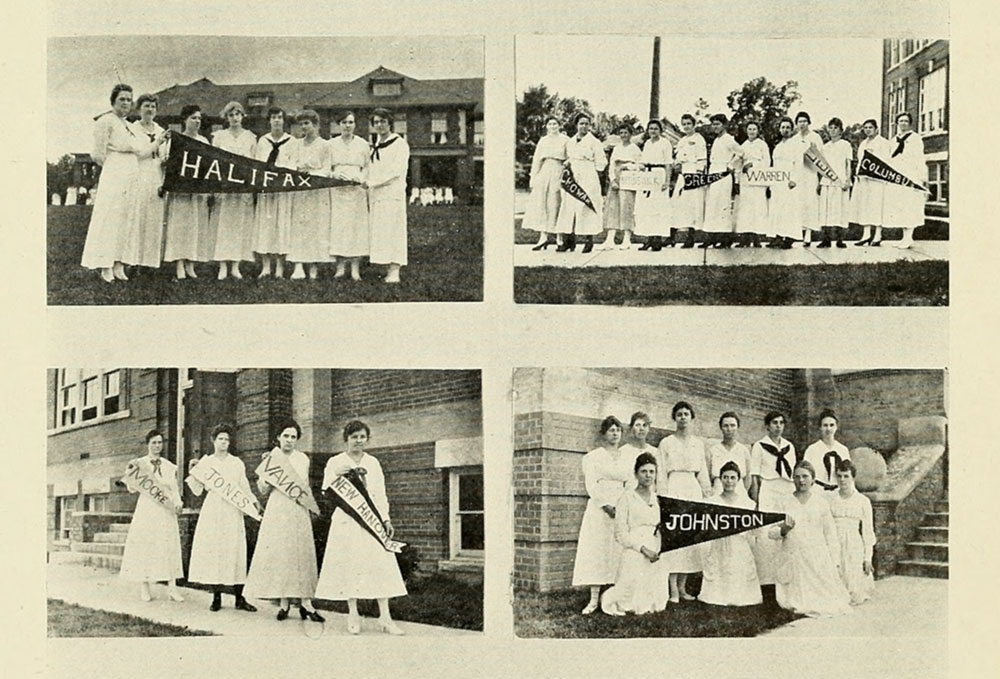Shortly after classes began in October 1908, President Robert Wright appointed a committee to make recommendations regarding how best to foster "social activities for the student body." While faculty guidance was important, the "social activities committee" emphasized that students should take the lead in organizing clubs. The first campus-wide organization to appear was the Young Women's Christian Association (YWCA). Men promptly organized the Jarvis Literary Society. By the fall of 1910, women had organized two literary societies, the Edgar Allan Poe and Sidney Lanier societies, both with distinctively Southern cultural ties. In addition, "county groups" were formed later. By the summer of 1917, photos published in the Training School Quarterly recorded the presence of "county groups" representing Pamlico, Halifax, Johnston, Bertie, Duplin, Person, Camden, Wake, Greene, Columbus, Lee, Brunswick, Chowan, Bladen, Pender, Craven, Sampson, Franklin, Washington, Robeson, Wayne, Lenoir, Hyde, Northampton, Dare, Currituck, Carteret, Beaufort, Cumberland, Perquimans, Onslow, and Warren Counties. The same issue listed students enrolled in the summer session by county. Forty-three counties in North Carolina were represented.
County clubs, no doubt, evolved from these "county groups," but were organized later, toward the end of the Training School era. They reportedly appeared due to the combined efforts of students at the North Carolina College for Women, the North Carolina State College, the University of North Carolina, and ECTTS. "Critical conditions" at these schools prompted students to organize themselves, school by school, into so-called county clubs so as to make their voices heard in every part of the state. Each county club elected a chair responsible for contacting newspapers in their county regarding facts about their schools. The county club chair was also to meet with "prominent men in the county" and "send a statement of the conditions of the schools, their needs, and what this means to the future development of the State." "Not only the county chairmen, but all students, informed their parents and friends about the present conditions of the schools." In this way, county clubs hoped to influence the state legislature to "appropriate more funds to each school." In addition, county clubs sought more funding for "the rural, deaf and dumb, blind, and schools for the feeble-minded."
Far from being another social organization, county clubs had a political purpose: addressing the state legislature in Raleigh so as to let "the people of North Carolina know the conditions of the State schools." At East Carolina, they reflected, in the wake of enfranchisement, a new degree of political activism on the part of students. Soon, the political importance of clubs and organizations was being taught at the Model School and in local schools by ECTTS-trained teachers. While broadminded in terms of their support for higher education in North Carolina, these clubs were not, apparently, as concerned about conditions in the African-American institutions of higher education that had been established as part of the Jim Crow system of segregation in public schools.
Sources
- "75 Representatives of Counties in Meeting Start Statewide Campaign." The Daily Tar Heel. October 2, 1920. P. 1.
- Bratton, Mary Jo. East Carolina University: The Formative Years, 1907-1982. Greenville, N.C. Alumni Association, 1986.
- Dorsett, Josie. "Cooperative Drive for State Institutions." Training School Quarterly. Vol. 8, no. 2. January, February, March, 1921. P. 177.
- "Faculty and County Groups." Training School Quarterly. Vol. 4, no. 2. July, August, September, 1917.
- Ferrell, Henry C., Jr. No Time for Ivy. East Carolina University, 1907-2007. Greenville, N.C.: East Carolina University, 2006.
- Langley, Emily. "Teaching Government Through a Club." Training School Quarterly. Vol. 8, no. 2. January, February, March, 1921. Pp. 144-145.
- "Students U.N.C. Start Campaign." The Lincoln County News. December 23, 1920. P. 1.
Citation Information
Title: County Clubs
Author: John A. Tucker, PhD
Date of Publication: 6/19/2018
